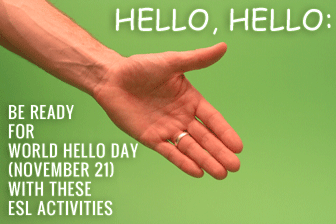Some people might consider themselves friendly: others might consider themselves shy. Either way, your students should be encouraged on a daily basis to use their language skills to interact with the people around them. They do not have to be alone in their efforts of reaching out, though. World Hello Day is an opportunity for everyone, all throughout the globe, to make an effort at reaching out to one another, taking steps towards world peace.
The primary means to achieving this personal connection is by simply saying hi. Encourage your students to participate in World Hello Day with the following activities that get them speaking to others and making meaningful connections with the people around them!
Celebrate World Hello Day with These ESL Activities
-
1
The Meaning of Hello
Your students will find a simple, concise but straightforward explanation for the origin of World Hello Day on its official website. Give your students the simple comprehension questions listed below and then let them access the web site. If you do not have computers in the classroom, print the information from the site and distribute to your students. By reading about the origins of the day and the intention behind World Hello Day, your students will gain appreciation for what a simple hello can do to change the world.
- When is World Hello Day?
- When was World Hello Day started?
- Why was it started?
- What is the purpose for World Hello Day in today’s world?
- How many people should you say hello to?
- What prestigious people have realized the value of World Hello Day?
- Instead of encouraging force, World Hello Day encourages what?
-
2
Say Hello
The goal of World Hello Day is to get participants to say hello to ten different people throughout the day. Challenge your students to speak up in a context in which they may not feel very comfortable by saying hello to ten people on the street. If your school is located in an urban area, give your students some time walking around the city, perhaps to a coffee shop or newsstand, to say hello to ten people. Ask your students to note how those people responded, then debrief the experience in groups of four or five students. Did some respond positively? Did others respond negatively? What do your students think the world would be like if everyone, everyday, made an effort to greet ten people that they ran into? What can they as individuals do to make the world a friendlier place? Ask your students to make some predictions as to what the world would be like if everyone made an effort to say hello to more people every day.
-
3
Hello Out of the Blue
Take the World Hello Day opportunity to say hello to someone you might not normally see by writing a personal letter to someone you care about. Start by reviewing the differences between a personal letter and a business letter. These differences include both structure and style. Then go through the parts of a personal letter: the heading, the greeting, the body, the complimentary close, the signature and the optional postscript. Encourage your students to think of someone that they care about whom they have not spoken with for some time. Then give the class an opportunity to write a personal letter to that person. Review how to address an envelope, and then drop the note in the mail. Though not the most common means of communication in the 21st century, most people still enjoy a hand written letter when it shows up in the mailbox! Some of your students may even receive a response in return.
-
4
Hello In Any Other Language
Give your students a chance to share some of their own culture by teaching the class how to say hello in their native languages. Every student will get the chance to be teacher for five minutes when he models the pronunciation and writing of his native hello and translates it directly into English. (For example, ni hao would translate directly to “you good?” but would translate in context to hello.) Once everyone has shared a bit of his native language, have students compare the different ways to say hello. How much variety is there among the global greetings? Do they get different feelings from different ways to express a greeting? If they could not use English or their native language, which other language would they use? Why?
-
5
What Does Peace Mean
Peace can be a charged subject, especially if you teach students from war torn areas of the world. Break your class into small groups to discuss the topic of peace, but be sure to be sensitive to each other’s position on the subject. What does peace mean to each person? What are symbols of peace? What can individuals do to promote peace throughout the world? Have groups of four to five students discuss these questions together. After discussing peace, have each group come up with a list of at least five actions that average citizens can do to promote world peace. You can display these actions on a bulletin board with an image of the globe in the center. Are any of them practical? Achievable? Ask your students to write about the steps that they can personally take towards making the world a more peaceful place.
Sometimes it may be difficult to believe, but one person really can change the face of the world. Help your students understand their own potential by encouraging communication and relationship with the people they meet every day.
By saying hello and trying to promote world peace, all global inhabitants will benefit!
P.S. If you enjoyed this article, please help spread it by clicking one of those sharing buttons below. And if you are interested in more, you should follow our Facebook page where we share more about creative, non-boring ways to teach English.








